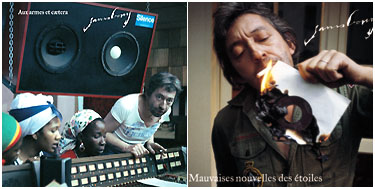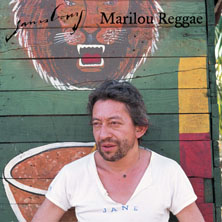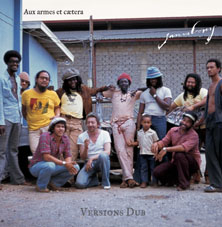Jamaican gainsbourg
Gainsbourg’s Reggae Albums Re-dubbed.
Paris
27/06/2003 -

Serge Gainsbourg may not instantly spring to mind as the “father of French reggae,” but when you take a close look at the history of French music in chronological order, there’s no denying his formative influence. For it was Gainsbourg, French chanson’s innovator supreme, who was the first to realise – light years ahead of his contemporaries – that Jamaican dub could play an active role on the French music scene. And the hits current French reggae stars such as Nuttea, Pierpoljak, Kana and Sinsémilia have scored over the past five years have confirmed Gainsbourg’s predictions.
While Nuttea, Pierpoljak and the other children of Marley’s generation have adopted reggae as a total lifestyle, Gainsbourg, the son of Russian émigrés, took a more cynical approach to it at first. Indeed, he openly ridiculed reggae ‘folklore’ in Negusa Nagast, singing “Believing’s as hazy as smoking ganja / Poor old rastaman, take another drag on your joint!” When Gainsbourg headed out to Kingston in January 1979 he was undoubtedly on a quest for new musical experiences. Following the excellent sales of his single Sea, Sex And Sun the previous summer – which Gainsbourg boasted he had done “for the cash and the cash alone!” – the French pioneer had his musical antennae waving in search of new sounds and inspiration.
On arrival in Kingston, Gainsbourg made a number of useful contacts via Bob Marley’s record label and came into contact with the I Threes (The Wailers’ famous female backing trio) and hot reggae double act Sly Dunbar and Robbie Shakespeare. Marley’s drummer and bass-player had gone on to become a legendary duo on the Jamaican studio circuit. And the six days they spent recording together were to make a lasting impact on Gainsbourg who later marvelled at "the incredible power and sheer dynamism of their rhythm. But it was six days of torture, non-stop interrogation... I lived those six days at 400 kilometres an hour!”
The Reggae Marseillaise
Kingston’s reggae élite gave Gainsbourg a reserved welcome at first, but things changed when they found out that the singer they were accompanying was the author of Je t’aime moi non plus – the only French song they’d ever heard of! The ten tracks for Gainsbourg’s album were finished within a week and Sly Dunbar declared Aux armes et caetera to be "the best reggae album ever made by a non-Jamaican!" French music fans appeared to share that opinion, too, rushing out to stores to buy their own copy. Aux armes et caetera ended up selling a staggering 1 million copies, catapulting Gainsbourg to the top of the French album charts for the first time in his career.
 Aux armes et caetera. In the meantime the French star had created his hard-drinking, chain-smoking alter ego, Gainsbarre. And reggae had gained a harder edge too, Bob Marley having succumbed to cancer and hundreds of Jamaicans being wiped out in inter-ghetto warfare. As a result recording sessions for all the major labels had been temporarily transferred to Nassau in the Bahamas. And it was there, in 1981, that Gainsbourg hooked up with the same team who had recorded with him in Kingston.
Aux armes et caetera. In the meantime the French star had created his hard-drinking, chain-smoking alter ego, Gainsbarre. And reggae had gained a harder edge too, Bob Marley having succumbed to cancer and hundreds of Jamaicans being wiped out in inter-ghetto warfare. As a result recording sessions for all the major labels had been temporarily transferred to Nassau in the Bahamas. And it was there, in 1981, that Gainsbourg hooked up with the same team who had recorded with him in Kingston.
Gainsbourg reworked
Recruited by former Wailers star Pete Tosh, Sly Dunbar & Robbie Shakespeare had gone on to enjoy a successful career with Black Uhuru and had also found fame on the international scene as a hot reggae double act – so Gainsbourg found himself working with the crème de la reggae crème. However, his second reggae album, Mauvaises nouvelles des étoiles, failed to repeat the success story of d’Aux armes et caetera, selling far less copies than its predecessor. One of the reasons for the album falling on deaf ears in France was undoubtedly the choice of final mix. Gainsbourg’s second album featured an ultra-heavy sound, inspired by what was happening on the Jamaican scene at the time, whereas on Aux armes et caetera the raw sound of Kingston had been deliberately softened for French ears.
When Bruno Blum, French journalist, singer and committed reggae fan, decided to breathe new life into Gainsbourg’s reggae classics earlier this year he chose to adopt a radically different artistic direction. After seeking authorisation from the original producer and Gainsbourg’s estate, Blum flew out to Jamaica last year carrying a very special cargo, namely the original master tapes of Aux armes et caetera and Mauvaises nouvelles des étoiles. His mission? To totally rework the mix on the two albums, keeping Gainsbourg’s original vocals and restricting the musical side of things to analogue sound and effects of the time.
The man Blum called upon to help him in his mission was Soljie Hamilton, a legendary sound engineer who had reigned at the Channel One studio in the 70s when Sly and Robbie held court. Blum and Hamilton decided to apply a pure Jamaican “dub style” to Gainsbourg’s songs, bringing out a whole new side to them. Their innovative reworkings of the two albums have, for instance, re-discovered certain instruments such as the imaginative keyboard-playing of Ansell Collins which had previously been hidden by guitars on Mauvaises nouvelles des étoiles. Far from distorting the originals, Blum and Hamilton’s reworkings give the songs even greater status, confirming Sly Dunbar’s prophecy that "the songs always sounded like dubs anyway."
Unfinished Symphonies

In the course of listening to the original master tapes recorded in Kingston and Nassau, Blum and Hamilton came across a number of major musical surprises. These included an unfinished version of the instrumental Planteur Punch and an alternative version of Ecce Homo (on which Gainsbourg predicted his own end, prophesying the fatal heart attack which would eventually end his career). On the re-workings of Lola rastaquouère and Brigade des Stups Blum and Hamilton have also resurrected fragments of lines from forgotten tracks and integrated them into their new dub versions.
The duo made only one exception to their decision to respect the original recordings, arranging for Marilou reggae to be re-recorded with new musicians including drummer Leroy Horsemouth Wallace and female bass-player Flabba Holt who have worked with the likes of Burning Spear, Israel Vibration and Pierpoljak. Incidentally, before featuring on Aux armes et caetera the song had already appeared on Gainsbourg’s 1976 album L’Homme à tête de chou, but this was only a timid foray into the world of reggae recorded the same year French disco king Claude François experimented with Jamaican sounds on C’est le reggae.
Bringing Gainsbourg completely up to date while at the same time confirming the French star’s place in reggae heritage, Blum and Hamilton took the novel step of inviting leading Jamaican DJs to rework his songs. Thus Lisa Dainjah effects a subtle play on words, transforming Gainsbourg’s Mickey maousse into Minnie Pussy and King Stitt (notorious for his ‘bad looks’) makes Des laids, des laids his own, re-inventing it as The Original Ugly Man. Meanwhile, Big Youth, an act who enjoyed tremendous popularity in Kingston in the late 70s, lays an English version of La Marseillaise over the music of Gainsbourg’s Aux Armes! The idea of a Jamaican rasta covering the French national anthem would doubtless have surprised Michel Droit, the disgruntled member of the Académie française who, in 1979, spoke out against Gainsbourg’s "scandalous parody" of the Marseillaise. Rather ironic really when you consider Gainsbourg's version was actually based on the original lyrics penned by Rouget de Lisle!
Bertrand Lavaine
Translation : Julie Street
02/03/2001 -
02/03/2001 -
02/03/2001 -
13/07/2000 -













